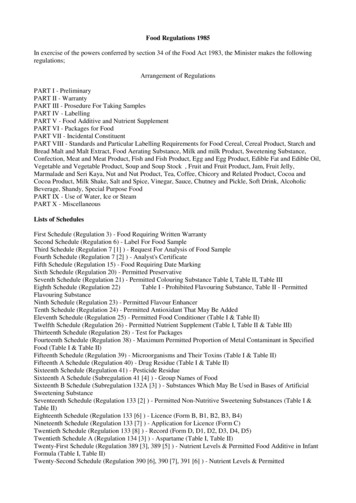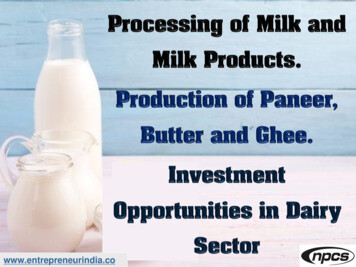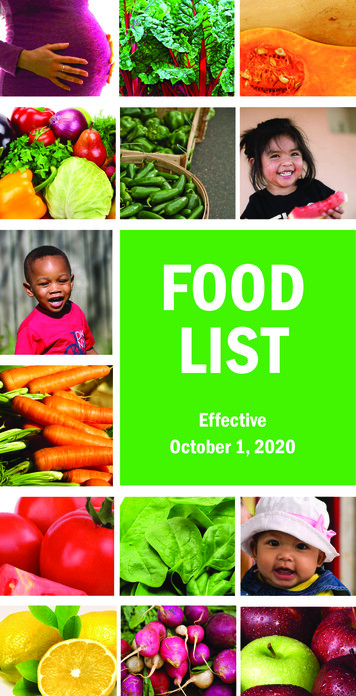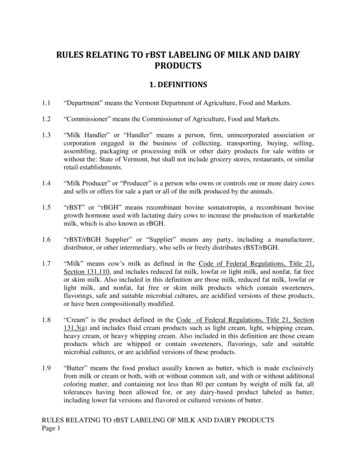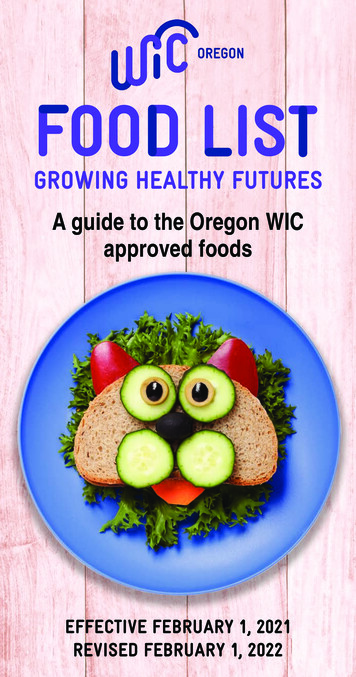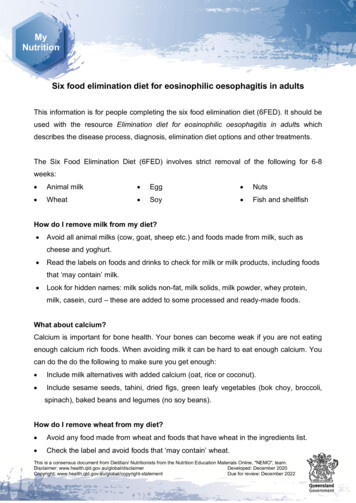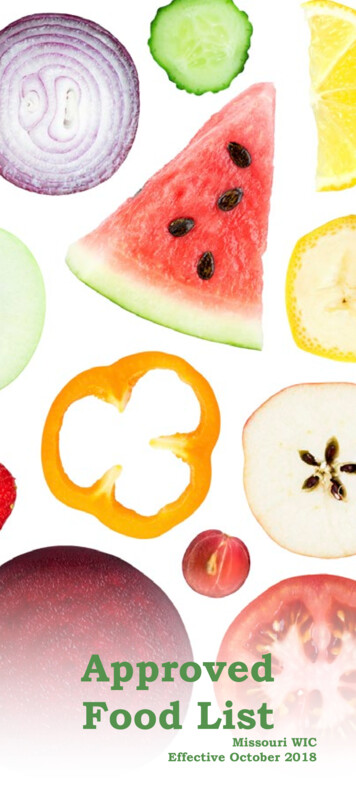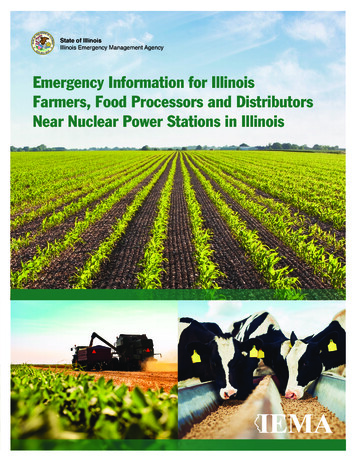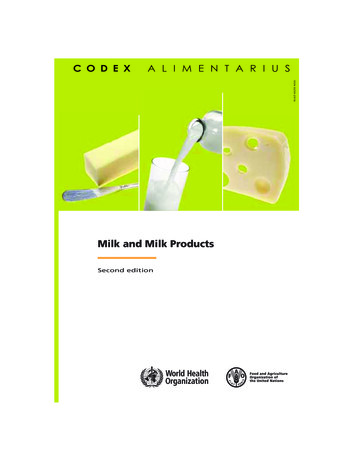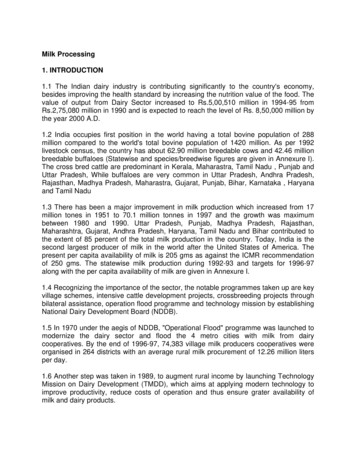
Transcription
Milk Processing1. INTRODUCTION1.1 The Indian dairy industry is contributing significantly to the country's economy,besides improving the health standard by increasing the nutrition value of the food. Thevalue of output from Dairy Sector increased to Rs.5,00,510 million in 1994-95 fromRs.2,75,080 million in 1990 and is expected to reach the level of Rs. 8,50,000 million bythe year 2000 A.D.1.2 India occupies first position in the world having a total bovine population of 288million compared to the world's total bovine population of 1420 million. As per 1992livestock census, the country has about 62.90 million breedable cows and 42.46 millionbreedable buffaloes (Statewise and species/breedwise figures are given in Annexure I).The cross bred cattle are predominant in Kerala, Maharastra, Tamil Nadu , Punjab andUttar Pradesh, While buffaloes are very common in Uttar Pradesh, Andhra Pradesh,Rajasthan, Madhya Pradesh, Maharastra, Gujarat, Punjab, Bihar, Karnataka , Haryanaand Tamil Nadu1.3 There has been a major improvement in milk production which increased from 17million tones in 1951 to 70.1 million tonnes in 1997 and the growth was maximumbetween 1980 and 1990. Uttar Pradesh, Punjab, Madhya Pradesh, Rajasthan,Maharashtra, Gujarat, Andhra Pradesh, Haryana, Tamil Nadu and Bihar contributed tothe extent of 85 percent of the total milk production in the country. Today, India is thesecond largest producer of milk in the world after the United States of America. Thepresent per capita availability of milk is 205 gms as against the ICMR recommendationof 250 gms. The statewise milk production during 1992-93 and targets for 1996-97along with the per capita availability of milk are given in Annexure I.1.4 Recognizing the importance of the sector, the notable programmes taken up are keyvillage schemes, intensive cattle development projects, crossbreeding projects throughbilateral assistance, operation flood programme and technology mission by establishingNational Dairy Development Board (NDDB).1.5 In 1970 under the aegis of NDDB, "Operational Flood" programme was launched tomodernize the dairy sector and flood the 4 metro cities with milk from dairycooperatives. By the end of 1996-97, 74,383 village milk producers cooperatives wereorganised in 264 districts with an average rural milk procurement of 12.26 million litersper day.1.6 Another step was taken in 1989, to augment rural income by launching TechnologyMission on Dairy Development (TMDD), which aims at applying modern technology toimprove productivity, reduce costs of operation and thus ensure grater availability ofmilk and dairy products.
1.7 With the liberalization of the Indian economy in 1991, the dairy sector too wasdelicenced. However, on June 9, 1992 GOI issued a Milk and Milk Products Order(MMPO), according to which, a dairy handling more than 10000 liters of milk per day isrequired to get itself registered. The registering authority shall be an officer of the StateGovernment or Union Territory in respect of units handling upto 75000 liters/day, or3750 MT of milk solids per annum, where the entire milkshed of the unit lies within aState / Union Territory. In case of those units, which are handling more than 75000 litersof milk per day or 3750 MT of milk solids per annum, the registering authority isDepartment of Animal Husbandry and Dairying ,Ministry of Agriculture, Govt. of India.2. MILK PROCUREMENT AND PROCESSINGThe organized dairy sector (both cooperatives and private) is presently handling only10-12 percent of total milk production in the country. The target and achievements ofmilk production, procurement and processing in cooperative sector by the end of VIIIFive year plan are given in Annexure II. Thus it indicates, there is a wide scope forprocessing of milk and manufacture of milk products for domestic consumption as wellas export.3. EXPORT PERFORMANCEDairy products form one of the fastest growing segments in the livestock product export.The major products exported are malted milk foods, ghee and cheese (to some extent)to the countries like Bangladesh, UAE, Nepal, Sri Lanka, Bahrain and Oman. Theexport performance during the years 1980-81 to 1995-96 are given in Annexure III.4. EXPORT POTENTIAL AND MARKETSBangladesh, United Arab Emirates, Nepal, Sri Lanka and Oman are the potentialcountries for export of malted milk products, butter and ghee. The export of milk andmilk products to currently existing markets would increase to Rs.285 million and to newmarkets to Rs. 155 million. Thus the exports is likely to touch Rs.440 million (APEDAestimates) by the turn of the century.The GATT agreement further gave a boost to the dairy industry, as India has acomparative cost advantage in regard to milk production. NABARD has been activelyinvolved in credit disbursement in number of schemes in dairy sector. It alsoencourages development of new products through its research and development fundsbesides guiding various entrepreneurs in new areas of business and technology.5. OBJECTIVES OF THE PROJECTThe financial assistance is extended for processing of milk with the following objectives.i) To enhance the keeping quality of milk and also to avoid economic losses to farmers.
ii) For manufacturing various milk products to make it available for the domestic marketas well as for export markets.6. TYPE OF PROJECTSThe type of milk processing projects that are normally considered for financialassistance are:i) Milk Chilling plants:It involves collection of milk from the villages, chilling the milk to 3-4 degree Celsius andtransporting to the main dairy for further processing and manufacture of products;ii). Market Milk Plants:It involves procurement of milk from the villages, chilling, pasteurization,homogenization, packing of milk of various brands (whole, standard, toned and doubletoned milk) and supplying them to the consumers. The surplus fat is converted intoghee or table butter or sold as cream to bakeries;iii). Composite Milk Processing Plants :The project involves the collection of milk and processing into market milk and productslike milk powder, cheese, butter, ghee, etc.;7. POTENTIAL AREAS:The scope for financing milk processing activities exists in the entire country. However,it is limited in East and North Eastern parts of the country because of under utilization ofexisting processing capacities, low milk production and scatteredness of productionbase.8. BENEFICIARIESThe beneficiaries may be individuals, partnership firms, companies, corporate bodiesand cooperative societies/unions.9. PROJECT DETAILS9.1 Land and Location:i) Ample space is required for buildings, future expansion, parking of transport vehiclesand for empty cans. About two acres of land is required for a milk processing planthandling about 10000 liters of milk per day (8 hours). However the built up area to total
area should be around 1:3 ratio;ii) The location of a plant should be close to the milk producing area in case of productsmanufacturing unit and if liquid milk is the main product it should be close to theconsumer;iii) The location of site should have proximity to road/rail facilities, services, such aswater, electricity and effluent mains, social infrastructure, etc.iv) The subsoil of the site should be firm with proper drainage.9.2 Site Development:i) Preferably the entire site should be fenced with barbed wire or compound wall isconstructed with gates at suitable places;ii) Internal roads should be of tar/bricks/WBM depending upon the soil conditions,rainfall and the number of vehicles moving every day.9.3 Layout and Buildings:The civil works comprises of factory building, quarters, office, garages, security post etc.The factory building for the milk reception, quality control, processing, packing andstorage of milk products should be as per the BIS. The total covered area depends onthe processes involved, products manufactured, the quantity of milk handled and theequipment chosen for services and product manufacturing. About 4000 sq.ft. area ofbuilding is required for handling 10000 liters of milk. The essential sections of a milkprocessing plant are given in Annexure IV. The layout plans for a plant of 10000 litersper day is given in Figure 1 .9.4 Plant and Machinery:The sectionwise equipment required, their specifications, quantity and costs for 10,000liters capacity plant are given in Statement 3. The machinery should be as per the BIS.Most of the dairy machinery are manufactured in the country by ALFA-LAVAL, L&T,HMT, Nichrome Pvt. Ltd., Samarpan Fabricators , Goma Engineering Ltd. etc.9.5 Technical Collaboration:Normally the technical collaboration may be for supply of machinery, technical knowhow for manufacture or marketing of products. If any such collaboration arrangement isthere, name of the firm, country and term of agreement is required to be mentioned.9.6 Manufacturing Process:The operations involved in the manufacturing process should be given in the form of a
flow diagram. The flow diagram for a 10,000 litre per day milk processing plant isfurnished in the Annexure V for guidance.9.7 Infrastructural Facilities for Raw Material and Utilities9.7.1 Raw Material:The principal raw material is milk. The extent of milk shed area, milch animal population, average milk yield, percentage of animals in milk, marketed surplus ,etc will determinethe size of the plant. The method of procurement, transportation of milk and input supplyto the farmers is required to be highlighted. The availability of other inputs such aspacking materials, disinfectants and consumable should be ascertained.9.7.2 Utilities:i) Power:Normally a three phase electricity supply is required for milk processing plants. Thepower requirement depends upon the load to be connected and the necessary approvalfrom SEB should be obtained for connection. Depending upon the position of powersupply, standby generators may be considered for connecting the essential sections.ii) Water:A milk processing plant requires the water in the ratio of 2:1 (2 liters of water for 1 liter ofmilk processed) for cleaning of equipment; cold storage and drinking purposes (sourceof water supply, quantity available and suitability for the purpose has to be mentioned).Accordingly, the size of the well is required to be designed and depends on the qualityof water, the water softening plant may be considered.iii) Steam:The steam requirement (kg/hr) depends upon the processes involved and the source ofsteam may be met by coal/oil/gas fired / electric boiler;iv) Fuel:LDO/coal/gas requirement and the availability to be ascertained.v) Compressed Air:It will be required for various pneumatic operations flow control operations as well as forcleaning purposes. The total requirement of compressed air and the capacity of thecompressors is required to be furnished.
vi) Vehicles :The vehicles required for procurement and distribution of milk depends on the quantityof milk to be handled. The number of vehicles required, source of supply, rental chargesetc. need to be furnished. Depending upon the need, the requirement of vehicles maybe considered in the project cost.vii) Other Services:Although a maintenance workshop is an integral part of milk processing for carrying outrepairs and maintenance of equipment.viii) Communication:Proper communication facilities is essential.9.8 Manpower:While selecting the site, the availability of manpower should be looked into and the totalrequirement of manpower depends on the operations involved and the quantity of milkhandled. For a plant handling 10000 liters of milk per day the manpower required isgiven in Annexure VI9.9 Environmental Aspects and Pollution Control:There are no hazardous effluents generated from a milk processing plant. However,construction of effluent treatment plant is necessary in case of multiproduct large sizeplants for treating the effluents before discharging for proper disposal. The final effluentshould meet the requirements of Pollution Control Board and is necessary to getclearance from them.9.10 Schedule of ImplementationThe activity wise schedule of implementation is to be given in the project.9.11 ProductsThe major products and by products proposed to be manufactured along with quantities,composition in terms of fat and SNF and costing should be indicated.9.12 Marketing and Selling ArrangementsThe market for the product (domestic and export), type of arrangements for distributionand sales, commission and additional incentive to be given, the proposed net work andthe advertisement plans should be furnished. Detailed market survey report is required
to be submitted.9.13 Business Prospects:It involves the present demand-supply for various products, gap in supply and expecteddemand for various products. The major competitors and their present share is to beascertained. The company projections for the next 3-5 years and the basis for projectionmay have to be furnished. The product wise quantities and countries where it is to beexported need to be mentioned.10. CAPITAL COST OF PROJECT:Broadly the capital cost includes the cost of land, development of land, fencing, internalroads, civil works (Plant building, office, quarters, godowns, etc.), plant and machinery,preliminary and preoperative expenses, margin money for working capital, etc. Salientfeatures of 10000 litre model milk processing plant is given in Statement 1.Capital costof a model dairy processing plant with capacity to process 10000 litres per day worksout to Rs.116.581 lakhs. The project cost comprises of Rs. 4.81 lakhs on land and landdevelopment , Rs.14.52 lakhs on civil structures, Rs. 64.38 lakhs on plant andmachinery , Rs.22.43 lakhs on account of misc. fixed assets, deposits & preliminary andpreoperative expenses, Rs. 3.50 on vehicles, Rs.4.57 lakhs of contingency and Rs. 2.37lakhs of margin money for working capital. The detailed assessment of working capitaland extent capitalised as margin money on working capital are presented in statement2. The details of project cost are furnished in statement 3.11. ECONOMICS OF THE PROJECTBased on the various techno-economic parameters, the economics of the project has tobe worked out for the project period or till the repayment of bank loan. The items ofincome includes sale of liquid milk, milk products and miscellaneous items. while theexpenditure includes the cost of raw material, transportation and commission, power,fuel packing distribution, wages and salary, repairs and maintenance, insurance,advertisement and other overheads. The income as well as expenditure for each yearhas to be worked out and then it should be subjected to cash flow analysis. For themodel diary processing plant of 10000 litres per day, the relevant techno-economicparameters are furnished in statement 4. The methodology for estimating the incomeand expenditure is given in statement 5 and 6 respectively. The depreciation scheduleson straight line method and written down value are worked out (statement 7).12. FINANCIAL ANALYSIS:The cash flow statement covering the Benefit Cost Ratio (BCR), Net Present Worth(NPW) and Internal/financial rate of return (IRR/FRR) has to be worked out for theproject. Normally the BCR should be greater than 1, NPW should be positive andIRR/FRR should be greater than 15%. For the model project under consideration, theBCR is 1.12:1, NPW is Rs. 134.75 lakhs and IRR is more than 50%. The details of the
cash flow analysis (without considering income tax) is given in statement 8. For arrivingat the tax liabilities, profit before tax was estimated and income tax was considered@35% as per the existing rates . On post tax income the FRR of the project is workedout as shown in statement 9. The entire bank loan can be repayable in six yearsincluding one year grace period during which only interest will be recovered (statement10).13. FINANCIAL ASSISTANCEThe projects on milk processing including manufacturing of milk products would beconsidered for refinance support by National Bank. Therefore, all participating banksmay consider financing this activity subject to their technical feasibility, financial viabilityand bankability .14. LENDING TERMS AND OTHER REQUIREMENTS:14.1 Margin Money:The promoters/company should normally meet 25% of the project cost out of their ownresources. However, NABARD could consider providing margin money assistance insuitable cases.14.2 Interest Rate:Interest rate will be determined by RBI/NABARD from time to time.14.3 Security:As stipulated by the RBI.14.4 Repayment Period:Depends upon the gross surplus generated, it may be upto 8 years with first one/twoyears as the grace period.14.5 Refinance Assistance:NABARD provides refinance assistance as per the existing pattern from time to time.15. CHECK LIST:A check list of various points to be considered for feasibility of the project is appended.Statement 1Project at a glance for 10000 litres model milk processing plant
123Land requirementMilk handling capacityProducts to be manufactured45678MarketCost of the projectBank loanMargin money (Down payment)Financial viability ( at 15% D F )BC RNPWIRRFRR ( Considering income tax liability)Repayment92 acres10000 liters/dayToned milk, Standard milk, Cream,GeeDomesticRs. 116.581 lachesRs. 87.436 lachesRs. 29.145 laches1.12 : 1Rs.134.75 lakhs 50% 50%6 years with one year grace periodStatement 2CALCULATION OF MARGIN MONEY ON WORKING CAPITAL(Rs. in lakhs)Sr.No. ParticularsUnit Period Yearscost days(Rs.)123456Stock in progressPacking materialChemicals & detergentsStores, spaces and fuel**Finished goodsToned MilkStandard MilkSaleable CreamSaleable .2200.4006.6865.670
Total ( 1 to 6)Less sundry creditors (days)Total working capital requiredMargin money @ 25% of workingcapitalBank Cash creditInterest on working capital @ * Outlay on stores and spares is considered @ Rs.0.19, Rs.0.17, Rs.0.15 per litreduring first year, second year and third year onwards respectively on assuming 40% ofpower and fuel charges and repairs and maintenance. (statement 5).Note : 1. Interest on working capital during first year is considered for 6 months only.2. It is assumed that payment to the producers are made once in a week.Statement 3CAPITAL COST OF THE PROJECTSr. ParticularsNo.Specification Quantity Unit(Rs)1A)i)345--2 acres78000/acre 1.56brick wallSteelWBM--424 RM2---165/RM15000 eachLSLSii)iii)iv)vi)B)i)2LAND AND SITE opment chargesGatesLand leveling and roadsWater Supply (borewell, tank,pump)TotalCIVIL WORKSDairy plant buildingE T Tanks0.700.300.501.754.81RCCACCii)Cost TotalCost(Rs. sq.ft.2.00LS0.75
iii)iv)v)D)i)ii)iii)iv)Condenser tankSuperviser quartersWorkers quartersTotalPLANT AND MACHINERYCan conveying and washingsystemWeigh scaleDump tank and accessoriesDetergent tankMilk chillerCream SeparatorMilk pasteuriserStorage tanksS S tanksPackaging machine & accessoriesGhee boilerGhee storage tankBoiler & accessoriesD.G. setRefrigeration equipmentElectrical panels & cablesPumpsS S pipes & fittingsErection & commissioningTotalMISC. FIXED ASSETSFurnitureComputerFire fighting equipmentCollection centre equipmentv)vi)vii)viii)ix)Work tableMilk cansCrate conveying system & trolleysLab equipmentEffluent treatment xiv)xv)xvi)xvii)xviii)xix)-ACCACC-LS450 sq.ft. 250/sq.ft.600 sq.ft. 180/sq.ft.0.571.121.0814.52----LS1.23500 kg1000 lts-3000-5000lph2000-5000 lph5000 lph10,000 lts300 lts2500 pph500 kg1000 lts300 kg/h62.5KVA------2111112111111-1 02.5064.38-Pentium-Centrifuge,butyr.20-40 lts 0-500----LS600LSLSLS0.283.000.522.503.25
x)Water softener-TotalE) VEHICLESssi)Jeep Mahindraii)Scooter BajajTotalF) DEPOSITSi)State electricity board-ii)Telephone-TotalPRELIMINARY & PREOPERATIVEEXPENSESi)Incorporation of companyii)Project preparationiii) Market surveyiv) Establishment ( Salary & wages )v) Travellingvi) Consultancyvii) Administrative expensesviii) Interest during constructionTotalH) CONTINGENCY ( @ 5% of cost ofbuildings, plant & machinery andmisc. fixed assets I)J)MARGIN MONEY FOR WORKINGCAPITAL( 25% of first year's requirement statement - 2 )GRANDTOTAL(A B C D E F G H )2.37116.58Statement 4TECHNO ECONOMIC PARAMETERSS.No Particulars1.Installed capacityUnitIlitres /day 10000YEARSIIIII onwards
2.Capacity utilisation3.4.No. of Working daysRaw material – Milk5.6.Cost price of milkCommissiononcollectionTransportation chargesPower and fuelPacking materialChemicals & detergentsSalaries and Litreslakhlitres/yr.Rs. /litremilk Rs. /litreRs. /litreRs. /litreRs. /litreRs. /litreLakhs Rs./yrRepairs and maintenance Rs. /litreOver heads (incl. Of Rs. /litreinsurance)Milk distribution costRs. /litreProduct mixToned milk (3% fat)litres /dayStandard milk (4.5% fat) litres /dayCream (50% fat)litres /daySaleable cream (25% of litres /dayiii approx.)GheeKg/daySelling pricesToned milkRs. /litreStandard milkRs. /litreCreamRs. /litreGheeRs./kgDepreciation (%)Civil StructuresPlant and MachineryMisc. Fixed assetsStatement 0109.0010.0040.00110.009.0010.0040.00110.00Written down valuemethod102533line
INCOME PROJECTIONSS.No v)Milk procuredYield per dayToned milk ( 3% fat )Standard milk (4. 5% fat )Cream ( 50% fat )Saleable cream ( 25% of iii approx. )GheeIncome per dayToned milk (Rs.9.00 / litre )Standard milk ( Rs. 10.00 / litre )Cream ( Rs.40.00/ litre)Ghee ( Rs. 001425000250046011516956002800555135206Rs. LakhsRs. LakhsRs. LakhsRs. 0.2800.0540.2274Total income/dayRs. Lakhs 0.8100.9321.0655Income per year (1st year for 6 months Rs.i.e. 182 days)lakhsIn 147.411 340.144 388.579Statement 6EXPENDITURE PROJECTIONSS.No ParticularsUnitI1.2.3.4.5.Milk processing per yearLakhlitres/dayRaw material - milkRs.7.40/litreCommission on milk collectionRs.0.20/litreTransportation chargesRs.0.20.litrePower and fuel (As per statement -YEARSIIIIIonwards12.740 29.200 243.0906.5706.57010.841
6.7.8.9.10.11.No. 4)Packing materialChemicals & detergentsSalariesandwages(asstatement4)Repairs & maintenanceOverheadsMilk distribution cost (Asstatement 4)Total operational .680 13.1402.044 2.3009.492 9.492Rs.0.05.litreRs.0.06.litreper --0.6371.5297.6441.460 1.6433.504 3.94217.520 19.710Rs. lakhs125.253 284.264 317.297Statement 7DEPRECIATION SCHEDULES OF CIVIL WORKS, PLANT & MACHINERY ANDMISC. FIXED ASSETSNote : The figures corresponding to each year represent end year values for thepreceding year.Statement 8CASH FLOW ANALYSIS WITHOUT CONSIDERING THE INCOME TAX LIABILITY(Rs. In lakhs)Sr.No. ParticularsIIIYearsVIIII to V1.2.3Costsi) Capital cost ii) Recurring costTotal costBenefitsi. Residual value ofa) Civil Structuresb) Plant & machinery & misc. fixedassetsTotal benefitsNet benefits (3-(1 44317.296 317.296317.297 317.297388.579 12388.579 431.79771.283 114.50111.906--
4D F at 15%a) P W of costs @ 15% DFb) P W of benefit @ 15% D F56D F at 50%N P W at 50% D F0.8690.756208.095 214.904128.100 257.148BCR 1.12:1NPW 134.750.6670.444-61.36924.810IRR is more than50%.1.726 0.432547.654 137.072670.687 186.5360.625 0.08844.552 10.076 The capital cost considered excludes the capitalised margin money on workingcapital.Statement 9CASH FLOW ANALYSIS ON CONSIDERING THE INCOME TAX LIABILITY(Rs. in lakhs)Sr. ParticularsYearsINo.1 Income (Statement 5)147.4112 Operational cost (Statement 125.2536)3 Gross operating profit22.1584 Lessi) Interest on term loan @ 16% 9.609ii) Interest working capital @ 0.56916%iii Depr. On straight line methodCivil works1.452Plant and machinery16.096Misc. fixed assets5.263iv. Amortisation of preliminary 0.215and preoperative expenses5. Profit before tax-11.0466. Tax at 35%0.0007. Net profit-11.046IIIIIIVVVI340.144 388.579 388.579 388.579 388.579284.264 317.297 317.297 317.297 317.29755.880 71.283 71.283 71.283 71.28312.812 10.250 7.5591.326 1.564 20.2151.0596.7911.5830.21526.997 46.661 52.512 57.528 61.9869.449 16.331 18.379 20.135 21.69517.548 30.330 34.133 37.394 40.921
8.9.Net income available (7 4)Net benefit after tax (capitalcost in 1st yr. residualvalue in last year)10. Financial rate of return (%)Discount factor @ 45%Discounted financial returnsDiscount factor @ 50%Discounted financial returns22.158 46.431 54.951 52.903 51.148 49.588-82.242 46.431 54.951 52.903 51.148 67.9800.1326.735Year Loan outstandingPrincipalInt. onTermLoan Int. onWorkingcapitalTotalNetrepayincomement(4 5 .53410.178 22.15830.154 46.43128.631 54.95125.940 52.90323.550 51.14816.976 49.588135.429 277.178D S C R 2.047:10.1089.9850.0878.148F R R is more than 50%Statement 10REPAYMENT SCHEDULE(Rs. in lakhs)1234562Begining of year80.07780.07764.06247.24630.42913.3123End of .6111. During the first year the average loan utilisation is considered at 75% of thetotal amount.2. Repayment period : 6 years including 1 year grace period.3. Interest on Term loan and Working loan is assumed @ 16% per annum.
Annexure ISTATE WISE CATTLE AND BUFFALOES, MILK PRODUCTION AND PER CAPITAAVAILABILITY OF MILKPopulation – in thousands (1992 census)Production – in thousand tonnesAvailability – in gms.Sr. Name of the stateNo.CattleCross Indige- Totalbred1 2.3.1. Andhra Pradesh2212. Arunachal Pradesh 73. Assam1364. Bihar655. Goa46. Gujarat1267. Haryana1598. Himachal Pradesh 1229. Jammu & Kashmir 25110. Karnataka27711. Kerala90512. Madhya Pradesh8913. Maharashtra89714. Manipur2815. Meghalaya1016 Mizoram317 Nagaland4518 Orissa26219 Punjab73020 Rajasthan4321 Sikkim1622 Tamil 94521643293Buffaloes Milk production Per capitaavailability1992- 1996- 1994-959397Target6.7.8.9.47294221 440016332244642986987408025863250 3390972036398131304459 475028022204062 406263046866370033241778090025723153004 32601731102117 237019235015048 520519532014811 8086215 710079540915103 53502961323420015523695 3867174
23242526TripuraUttar PradeshWest BengalUnion TerritoriesGRAND 440387685813520912380191Source : Directorate of Economics and Statistics and State Department of AnimalHusbandry and Dairying.
Annexure IIDAIRY DEVELOPMENT TARGETS AND ACHIEVEMENTS FOR VIII FIVE YEARPLANSr. No.ParticularsTargetsAchievements1.2.3.4.56Milk production (million tonnes)Per Capita availability (gm)No. of Milk shedsNo of Dairy Co-operativesAverage milk procurement(LLPD)Processing 22.60265.10Annexure IIIYEARWISE EXPORT OF DAIRY 643380020318957NA(Rs. in crore)1.991.042.411.248.3712.4740.1132.57
Annexure IVESSENTIAL SECTIONS OF A MILK PROCESSING PLANTThe milk processing plant shall have the following essential facilities.i) Raw Milk Receiption Dock (RMRD) - consisting of can conveyor, can washer,weighting balance, dump tank etc.ii) Processing Hall - cream separator, chiller, homogenizer, pasteuriser and otherrelated machinery are installed.iii) Storage area- for milk storage tanks.iv) Products manufacturing area-depends upon the type of products and the quantity ofmilk handled, the required equipment needs to be installed.v) Packing area-for packing of liquid milk and other products.vi) Cold storage-for keeping the milk and milk products before sending to market.vii) Quality Control Laboratory-for testing the quality of milk and milk products.viii) Utilities area-for installing boiler, generator set, water treatment plant, maintenanceand store area for spares.ix) Waste water treatment plant area-for treating the dairy effluents before releasing tothe fields.x) Quarters and office area-for all the essential staff.xi) Vehicle parking area-both for the milk procurement and distribution vehicles.xii) Input supply area- for providing veterinary service, supply of feed, fodder seeds, etc.
Annexure VISALARIES AND WAGESSr.No. Particulars1.2.3.4.5.6.7.8.9.10.Plant ManagerProcurement officerField supervisorsProcessing supervisorsMechanicsDriverWatchmanAdministrative staffLaboratory staffUnskilled labourTotalOther perksTota
packing materials, disinfectants and consumable should be ascertained. 9.7.2 Utilities:- i) Power: Normally a three phase electricity supply is required for milk processing plants. The power requirement depends upon the load to be connected and the necessary approval from SEB should be obtained for connection. Depending upon the position of power
